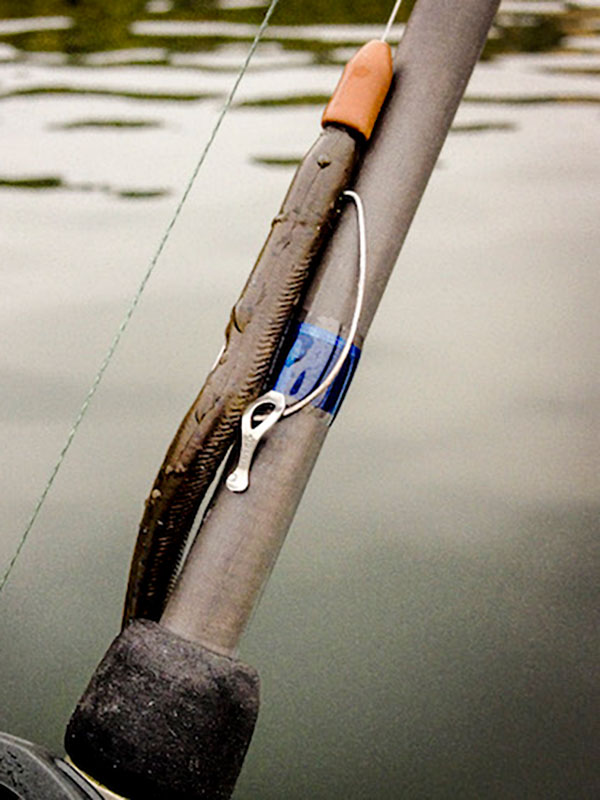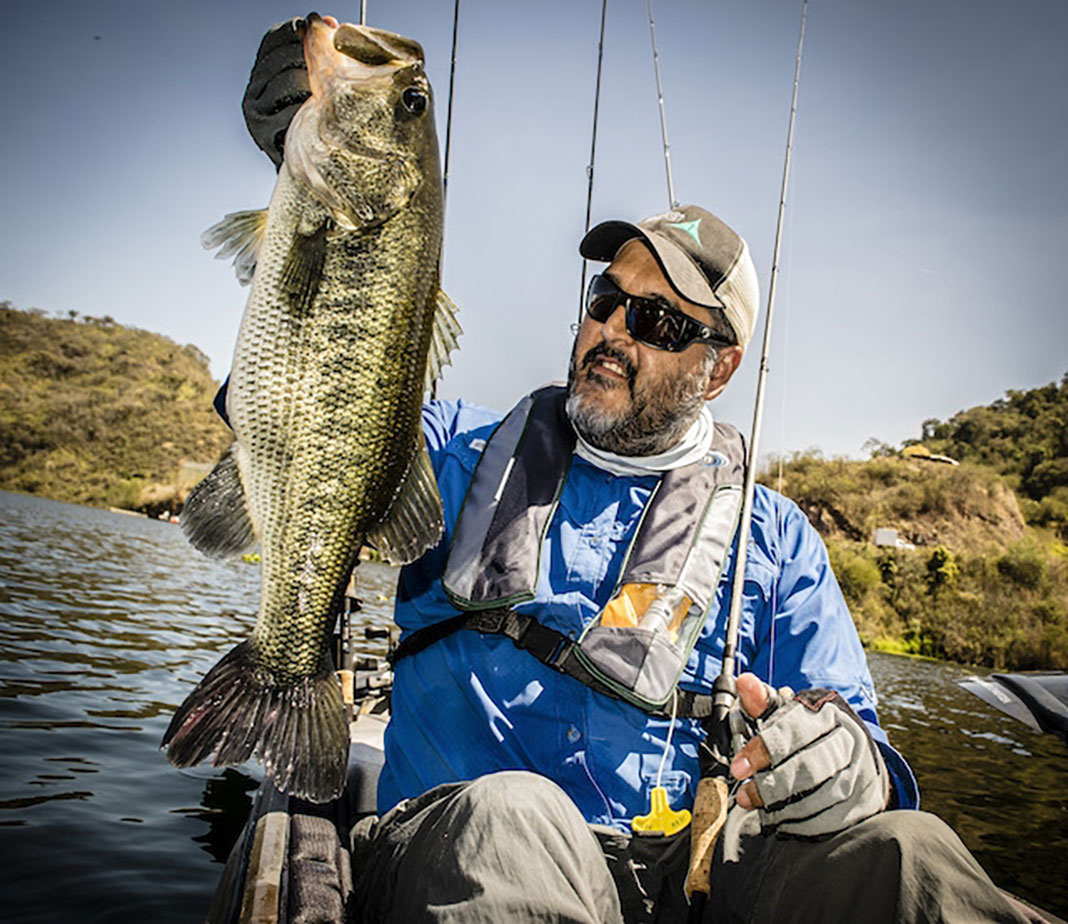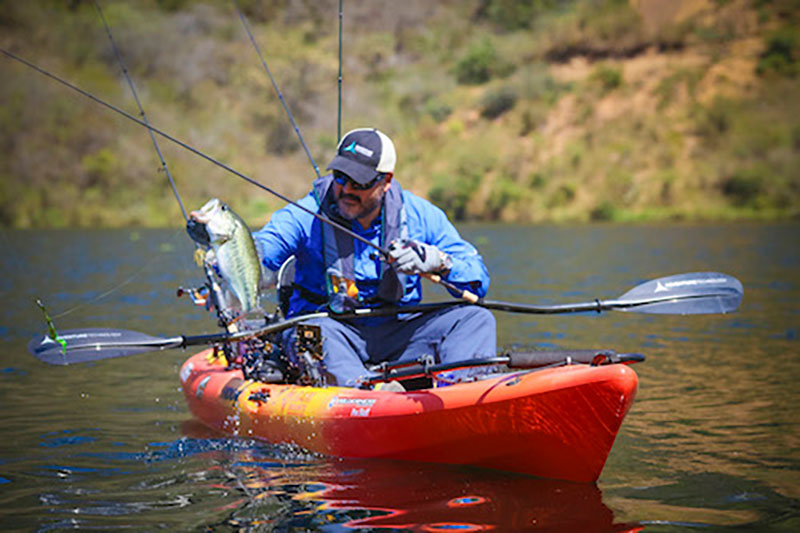Everyone has a favorite rig. For me it’s the Texas rig. The basic Texas rig is comprised of a free-sliding bullet weight, a worm hook and a soft plastic lure. I find myself throwing a Texas rig almost every time, everywhere. Yes, I like to use a lot of techniques, and I certainly try to find a pattern with different lures. But, to be honest, I just plainly enjoy throwing a rigged worm for many situations. It has a natural simplicity to it, and regardless of innovative techniques that are constantly appearing, this tried and true technique continues to be a mainstay for most largemouth bass anglers around the world.
Being my favorite bass fishing rig, I apply a few small twists to the technique that help me to enjoy it more and catch more fish. They are very simple and may already be familiar to you, but if you haven’t tried them, I invite you to do it next time you’re out on the water. If you are a novice angler or are transitioning from boat to kayak fishing they may be particularly useful. I hope you find these tips as helpful as they have been for me.
10 Tips to Master the Texas Rig

1 Use Tungsten Bullet Weights
Nowadays I use tungsten weights 100% of the time and I recommend you to do it as well. They might be more costly but they will hang up a lot less and you will loose far fewer rigs, so it really is not that expensive as it may seem. A tungsten weight will transmit bottom feel better and being smaller, it will give you better presentations and it’s also easier on the environment than lead.
2 Avoid Shiny Bullet Weights
I cannot think of a situation that a shiny weight will give you better results. I feel a painted weight keeps the attention on my lure and not on the weight itself, especially with spooky fish. I buy painted tungsten bullet weights but when that’s not possible, I paint them with nail polish. Matte nail polish, that is. It is surprisingly durable and easy to apply, just use toothpicks to hold the bullet weights to a cardboard or styrofoam piece, and give them two or three paint hands. If you leave them to dry overnight, they will be almost as hard as a factory-painted weight. So go ahead and paint that shine away!
3 Prefer Light Wire Hooks
Hooksets from a kayak are not as solid as from a boat, as the kayak will likely glide a bit, especially on those eye-popping hooksets that we Texas-rig fishermen normally do. That is why I use high quality, light wire hooks. They will give you better penetration with less force than stouter hooks. They will also bend a bit when you pull up a hang-up, usually just enough to free your rig. But do change hooks afterwards, you never know when that 10-pounder will strike.
4 Keep Your Lure and Tackle Selection Small
You don’t need tons of lures, weights and hooks. Most likely, you will also be carrying other rods, lures and gear, so less is for me, always better. You will do just fine for a day’s fishing with a small number of 1/8, ¼, 3/8 and ½ oz weights.
As to hooks, you will be perfectly fine with 1/0, 3/0 and 5/0 light wire, wide gap hooks. I also carry a few offset round bend hooks for thinner lures in 1/0 and 3/0 sizes.
I tend to carry three or four lure types. I think of them as little action, medium action, and live action. For me, that is a senko, a lizard and a creature (most likely a brush hog). Of course there are many more but if you want to have the basic, these three lure types will cover most situations. As to colors, my do-it-all color is the green pumpkin/red flake. It will work well in clear and stained water. If you want more then you can bring watermelon for clear water and black/blue or red flake for muddy conditions. I also carry a pack of small craws or shaky head worms for finesse Texas presentations when needed.

5 Dye Your Lure Tips
I don’t know the reason but sometimes, dying your lure tips will markedly increase the number of fish you catch. It just works sometimes, in clear or muddy water so I always carry a bottle of lure dye, just in case. I prefer garlic-scented chartreuse dye in a bottle.
6 Use a Scent Stick
There’s no doubt in my mind that a scented lure will give you more time to set the hook. In windy situations where you have to make repeated paddle strokes when your lure is in the water, every additional second to make the hookset is appreciated. Use a stick scent, it will be much less messier and it will last much longer in your lures than a liquid-based scent.
7 Use the Right Rod and Reel
For general Texas rigging I use a Kistler 7’ medium-heavy, fast action rod and a fast baitcasting reel. A high quality rod will give you the sensitivity you need for those soft bites, and a high ratio reel (7:1 or more) will retrieve your lure faster once you are outside the strike zone, so you can make more casts. For 3/8 and ½ oz weights I prefer a heavy-powered Kistler baitcasting rod 7’ to 7’3” in length.

8 Use Braid Main Line and Fluorocarbon Leader
To increase hookups in deep water and to a distance, I recommend you use braid as your main line. It will give you solid hooksets to compensate for kayak movement. Believe me, once you tame the braid (if you’re not used to it) you will not want to go back. To keep line visibility low, use long fluorocarbon leaders approximately 12 feet long (or about two rod-lengths, from the reel to the tip top). This is basically to give you more room when retying lures, so you won’t run out of leader in a day.
Using braid/fluorocarbon will give you the great added benefit of easily breaking your line if you get into a fatal hang-up. If you use only fluoro or mono, the line will stretch and the kayak will become unstable when you try to break it free, it can even be dangerous if you are in very choppy water. If you use only braid, you may break a finger sooner than the line! I use an Alberto knot for joining lines. For general Texas rigging I prefer 30-lb braid and 12-lb (for light cover and open water) or 15-lb (for thicker cover) fluorocarbon leaders.
9 Don’t Forget the Finesse Approach
Fishing a light Texas rig can be lots of fun. It will also work wonders for pressured fish and to fill your limit in a tournament. For this, I use a Kistler Medium-power, extra-fast action spinning rod. A 1000-sized reel will do fine for casting 1/16-oz rigs. Spool your reel with 15-lb braid main line and a long 6 or 8-lb fluorocarbon leader and hang on. A 1/0 or a 1-sized straight shank finesse hook is perfect for small, thin lures. Four-inch shaky head or cut tail worms work extremely well for this approach. Start with green pumpkin or watermelon seed as your main color. Fish it very slowly, almost dead-sticking it. Most of the times you need only to drag it so slightly and the water itself will impart the action you need.
10 Use Heavy-Duty Gloves
Using heavy-duty gloves will allow you to break your line, manage fish and paddle confidently while protecting your hands from cuts, abrasion and sunburns. They are a great addition to any kayak fishing technique but particularly for bottom techniques where your lure hangs up more often.
These basic tips will give you more confidence while fishing with your Texas rig. All year round, in deep or shallow, stained or clear water, the Texas rig still shines as both a numbers and big fish catcher. So, the next time you’re out on the lake, break out the old Texas rig and have some fun!
Alejandro Pérez-Arteaga is a Wilderness Systems pro, as well as Kistler Rods, YakAttack, RAM Mounts and a member of the HOOK1 Crew. He lives and fishes in central Mexico.









